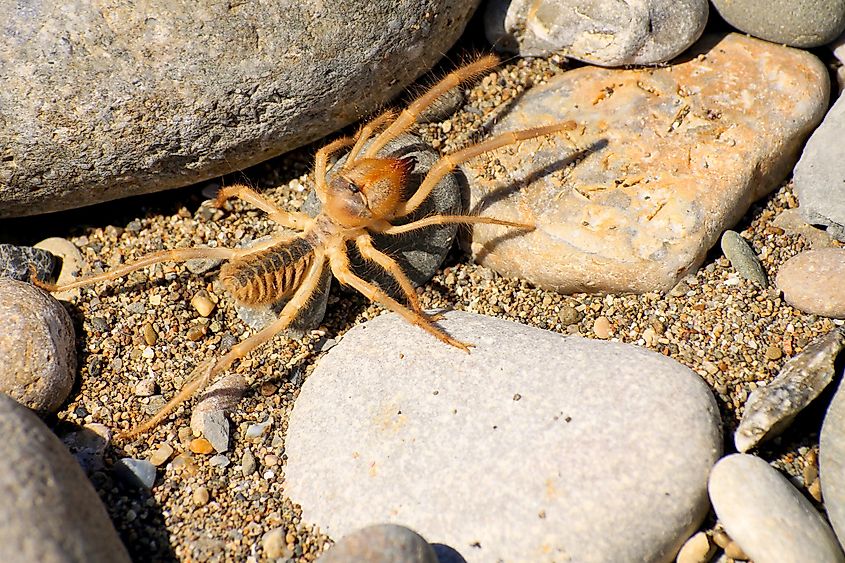
Camel Spider
For many people, the camel spider is the stuff of nightmares, a creature straight out of a horror movie. However, while its appearance is certainly intimidating, the camel spider is also a greatly misunderstood animal, thanks mostly to myths that grew up during the Iraq war in 2003. Images swept the Internet showing camel spiders the size of children, while stories abounded of them chasing and devouring humans and other mammals, all of which are untrue. Despite this, the camel spider remains a fascinating animal worthy of closer study, although much about them remains a mystery.
Characteristics

The camel spider belongs to an order of arachnids known as solifugids but is not strictly a spider, despite its name. Instead, it sits somewhere between spiders and scorpions. There are believed to be over 1,000 species, known variously by names such as wind scorpions and sun spiders, which range in size from a few millimeters up to 16 cm for the largest species. However, the vast majority remain unstudied, as they do not survive well in laboratories and are difficult to observe in the wild. Camel spiders are typically tan or dark brown in color, a form of camouflage to protect them from predators in the desert environments they inhabit. Their bodies are covered in fine hairs, which function as insulation to protect the spider from heat. The name camel spider originates from their habitation of desert regions and their color, which is similar to camels, while the term solifugae is Latin for “those who flee from the sun,” referring to their general dislike of direct sunlight.
Habitat And Behavior

Camel spiders are found on all continents except Antarctica and Australia, favoring desert terrain, but also occur widely in semidesert and scrub in the southwestern United States, the Middle East, Mexico, South Africa, and elsewhere. Three species are even found in Canada, tolerating the cooler temperatures of British Columbia and Alberta.
They are nocturnal creatures, avoiding hunting during the day due to their aversion to excessive heat. Instead, they will hide under rocks or in underground burrows, being accomplished diggers. While many of the stories regarding the camel spider’s diet are exaggerated, they are voracious animals, generally feeding on termites and beetles but are also known to hunt rodents, snakes, lizards, and birds. However, they will avoid prey items larger than themselves.
They locate prey using the pedipalps on their head, sensory organs similar to an insect’s antennae. These are also used to aid in movement, feeding, and fighting and are equipped with suction tips for grabbing prey. Once a prey animal has been caught, it is then sliced up by the camel spider’s prominent chelicerae, or jaws. These are incredibly powerful, capable of cutting through small bones or skin and shearing feathers. The prey is then liquefied and ingested through the pharynx. Again, contrary to popular belief, camel spiders do not attack humans unless provoked, but it is best to avoid them. While they are not venomous, their bite is excruciating, potentially causing swelling and even bleeding. However, a camel spider bite may prove fatal to smaller animals such as dogs or cats.

In terms of predators, it is thought that certain bat species, toads, and scorpions may include camel spiders in their diet, but given the difficulties of studying them in their natural habitat, this is still subject to speculation. Camel spiders are very fast, capable of reaching up to ten miles per hour, approximately half that of the fastest human sprinter, although even this appears to be comparatively rare behavior. They are solitary creatures, except when mating, which they do once per year, a behavior known as univoltinism. Prior to mating, females will gorge on food, as they do not feed once their eggs have been laid. The female will then dig a burrow, in which she lays between fifty and two hundred eggs. The young will then progress through a series of stages before becoming adults.
Threats And Conservation Status
Given that little is known about many species of camel spiders, assessing their populations and conservation status is not easy. As such, it is generally seen that camel spiders are not at any great risk overall. However, in Abu Dhabi, one species, Galeodes arabs, known locally as Yamel Al Aqrab, is considered endangered, mainly due to habitat loss. Here, they are safeguarded under federal law, making it illegal to collect them, while efforts are underway to create protected areas to conserve habitat and prevent disturbance. The Environment Agency of Abu Dhabi is responsible for monitoring the species, both inside and outside of protected areas.











